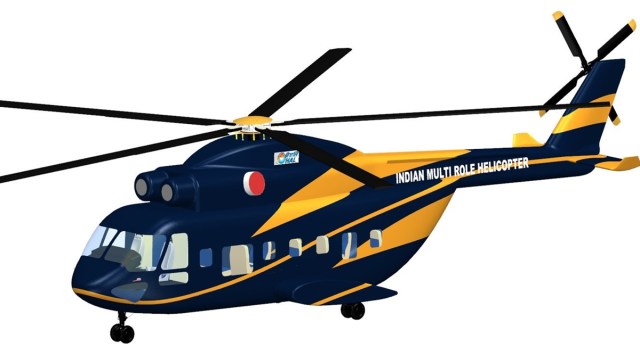- India
- International
After LCH induction, focus on indigenous medium-lift chopper
The state-owned aerospace major Hindustan Aeronautics Ltd (HAL) has over the last two decades rolled out three indigenously designed and developed helicopters in light category.
 The IMRH project is slated to be executed by the HAL in collaboration with private players, pending sanction from the government. (Hindustan Aeronautics Limited via Wikimedia Commons)
The IMRH project is slated to be executed by the HAL in collaboration with private players, pending sanction from the government. (Hindustan Aeronautics Limited via Wikimedia Commons)WITH THE Indian Air Force inducting the indigenous multi-role Light Combat Helicopter (LCH), Prachand, the focus is on the development of medium-lift category Indian Multi Role Helicopter (IMRH), to replace the fleets of IAF’s workhorse Mi-17 and other helicopters which will start phasing out over the coming decade.
Over the last two decades, Hindustan Aeronautics Ltd (HAL), the state-owned aerospace major, has rolled out three indigenously designed and developed helicopters in the light category (below 10 ton) – the 5-ton class Advanced Light Helicopter (ALH) Dhruv, its weaponised version ALH Rudra, and the LCH.
It has also developed a 3-ton class Light Utility Helicopter (LUH), primarily as a replacement for the French origin legacy helicopters Chetak and Cheetah. So the next logical step is a Made-in-India medium lift helicopter in the 13-ton category – the IMRH.
On March 11 this year, the Ministry of Defence identified 18 major strategic platforms for industry-led design and development. In line with the announcement in the Union Budget 2022-23 that allocated 25 per cent of defence research and development budget for industry-led effort, these 18 platforms have been identified for research and development under various routes.
The list includes the IMRH under the Special Purpose Vehicle model, where private industries will be encouraged to take up design and development, in collaboration with various government organisations. The IMRH project is slated to be executed by HAL, in collaboration with private players, pending sanction from the government.

On April 2, speaking at a function to mark 60 years of service of Chetak helicopters, Defence Minister Rajnath Singh emphasised the need to develop the IMRH which, he said, is a significant requirement for the armed forces and has a huge market potential.
He also pushed for fast-tracking the development of helicopter technology, saying this will not only be a key strategic asset in the defence sector, but will also make India a dominant force in the global helicopter market. “We need to make efforts to strengthen India’s claim in the rotary wing domain. The era is changing. I am sure that in the times to come, we will be more bright, strong and completely self-reliant,” he had said.
Senior defence officials said the IAF currently operates a fleet of over 220 medium lift helicopters, Mi-17 and its variants Mi-17IV and Mi-17V5, primarily used for utility and troop transport. With the estimated requirement touching 250 by 2028, and with Mi-17 fleets starting to be phased out, there will be a large requirement for medium lift helicopters.
The Army does not operate any medium lift helicopter and is dependent on the IAF for this. According to sources, the Army has a projected requirement of over 150 units of what is being called tactical battlefield support helicopters. While there is no timeline for this projected requirement, officials said the IMRH would fit the bill due to its proposed features.
#WATCH | The first indigenously developed Light Combat Helicopters (LCH) inducted into Indian Air Force at Jodhpur, in the presence of Defence minister Rajnath Singh and IAF chief Air Chief Marshal VR Chaudhari pic.twitter.com/sh3fqkTprg
— ANI (@ANI) October 3, 2022
The Navy operates close to 60 helicopters like Kamov and Seaking and the newly inducted MH-60R in medium lift category. Its projected requirement over the next few years is close to 120. Officials expect a large share of this requirement to be fulfilled by the IMRH.
HAL has already made considerable progress on designing the IMRH, based on the requirements of the armed forces. A detailed 3D model has been prepared and wind tunnel testing is underway. Sources said the IMRH will be rolled out in both unarmed and armed versions, and will be able to carry 24-36 personnel, depending on the configuration.
The unarmed variant will be used for troop movement, logistics support, casualty evacuation, electronic warfare platform, airborne fire fighting, VIP transport, disaster relief, and search and rescue. The armed version will be able to perform special heliborne strikes, commando or special forces tasks, counter insurgency and counter terrorism operations, urban warfare if equipped with precision guided munitions, and combat fire support to ground. It will have a maximum takeoff weight of about 13 tons and a payload capacity of 4 tons.
Officials said the programme is expected to take seven to eight years for completion, after getting the necessary clearances from the government.
Apr 26: Latest News
- 01
- 02
- 03
- 04
- 05







































